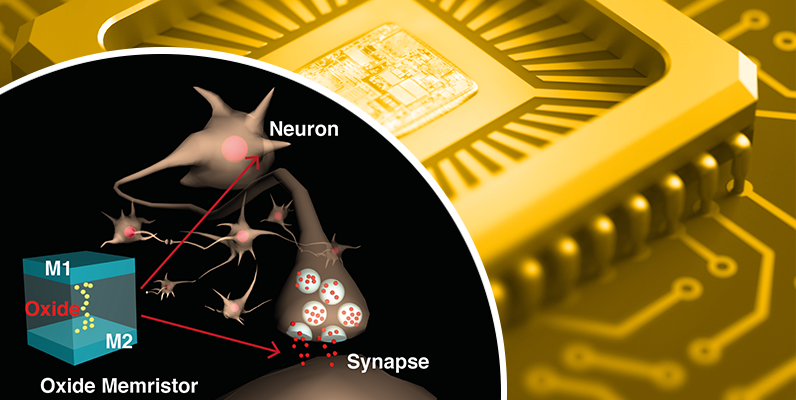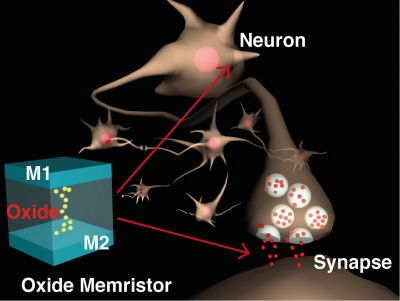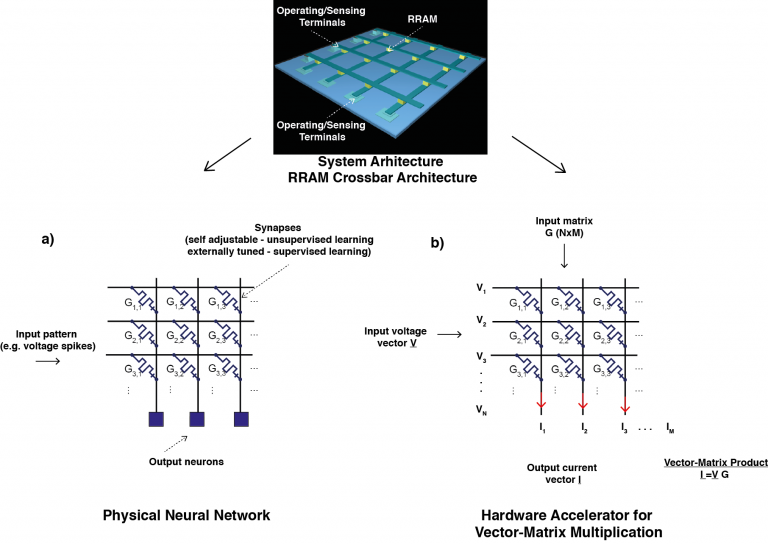Next-generation adaptive electronics for neuromorphic engineering

1 September 2017
Exploiting the potential of RRAM technology for extremely power-efficient neuromorphic systems, specifically Hardware Accelerators and Physical Neural Networks for ML applications
Funder Royal Academy of Engineering
Amount £ 500 000
Project website https://www.raeng.org.uk/news
Description

This project takes a fundamentally different approach to create a new neuromorphic technology. Resistive RAM (RRAM) technology, a subclass of memristive systems, is based on simple two terminals (metal-oxide-metal) nanodevices whose resistance can repeatedly be varied, with low operational energy & very high levels of integration. Apart from memory, memristors also enable computing. This is a crucial step in replacing a von-Neumann’s back-and-forth bottleneck by architectures that directly implement neuromorphic functions – most importantly synapse-like plasticity, and neuron-like integration & spiking.

Neuromorphic memristive systems promise to yield vast improvements in power efficiency, therefore, enhancing artificial intelligence in mobile and embedded systems. This can be leveraged in the “Intelligence of things” era with ML algorithms implemented directly on the board, facilitating efficient local data processing and enabling devices to make decisions locally, rather than to rely on data streaming and latency-prone cloud computing.
<p class="heading">
<br>
<em>
<strong>
"Exploiting the potential of RRAM technology for extremely power-efficient neuromorphic systems, specifically Hardware Accelerators and Physical Neural Networks for ML applications"
</strong>
</em>
<br>
" "
</p>
Outputs
- Publications
- A. Mehonic, M. Buckwell, L. Montesi, M. Munde, D. Gao, S. Hudziak, R.J. Chater, S. Fearn, D. McPhail, M. Bosman, A.L. Shluger. “Nanoscale Transformations in Metastable, Amorphous, Silicon-Rich Silica." Advanced Materials 28(34), 7486-7493, (2016) doi: 10.1002/adma.201601208
- A. Mehonic and A. J Kenyon “Emulating the electrical activity of the neuron using a silicon oxide RRAM cell.” Frontiers in Neuroscience 10:57, (2016) doi: 10.3389/fnins.2016.00057
- A. Mehonic, M.S. Munde, W.H. Ng, M. Buckwell, L. Montesi, M. Bosman, A.L. Shluger, A.J.Kenyon. “Intrinsic resistance switching in amorphous silicon oxide for high performance SiOx ReRAM devices.” Microelectronic Engineering.178:98-103, (2017). doi: 10.1016/j.mee.2017.04.033
- M.S. Munde, A. Mehonic , W.H Ng , M. Buckwell , L. Montesi , M. Bosman, A.L. Shluger , A. J.Kenyon “Intrinsic Resistance Switching in Amorphous Silicon Suboxides: The Role of Columnar Microstructure.”, Scientific reports 7.1 9274, (2017). doi: 10.1038/s41598-017-09565-8
- A. Mehonic, T. Gerard, A. J. Kenyon. "Light-activated resistance switching in SiOx RRAM devices." Applied Physics Letters 111.23, 233502, (2017). doi: 10.1063/1.5009069
- K. Zarudnyi, A. Mehonic, L. Montesi, M. Buckwell, S. Hudziak, and A. J. Kenyon "Spike-Timing Dependent Plasticity in Unipolar Silicon Oxide RRAM Devices." Frontiers in Neuroscience 12, 57 (2018). doi: 10.3389/fnins.2018.00057
 Close
Close

